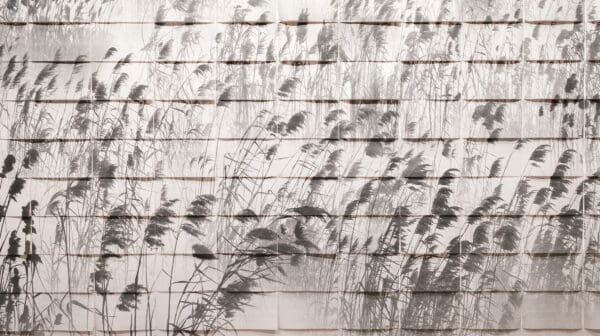
Poetics of Relation
Tender Comrade, currently on show at Sydney’s White Rabbit Gallery, creates a new vocabulary of queer kinship by reimagining the relationship between artworks, bodies and space.
From the time she was enrolled in Henri Van Raalte’s Perth School of Art at the age of 11, West Australian artist Elizabeth Blair Barber (1909–2001) remained a part of the state’s art scene for the next eight decades. Working at a time when women artists were not taken as seriously as their male counterparts, Barber used her vibrant social life as the wife of Charles Bunning (of the Bunnings Bros. hardware empire) to fuel her art practice and raise the profile of other female creatives by painting well-known figures from the West Australian art scene.
Like an influencer might take selfies today, Barber painted portraits of the people she met through art making, performing in theatre shows and ballet dancing. As a result, her oeuvre contains a lengthy record of influential creatives in Western Australia. Working with oils, watercolour and pencil drawing, Barber’s portraits documented many prominent female creatives of the time including theatre director, Nita Pannell AM OBE, journalist Josyln Summerhayes, artist Elizabeth Durack, and ballet dancer Robin Haig.
“She characterised herself as “running with the hares while hunting with the hounds,” says curator Connie Petrillo. “Elizabeth used this phrase to explain her ambivalent status in the Perth art world. Neither socialite nor professional artist, she occupied a border territory between the two that she inhabited at will.”
Looking over the vast amount of Barber’s artistic output, Petrillo worked with Barber’s son, Bob Bunning, to earmark 200+ works for conservation, framing and exhibition. Many of the works have been kept in storage by the Bunning family and have never been seen by the public. The exhibition spans Barber’s entire career, from drawings she completed in her youth to the still life paintings of florals Barber was known to paint in her later years. After spending so much time with Barber’s work, Petrillo sees her practice like a series of diary entries. “She had an intense personal vision that she put down on paper as quickly as possible,” Petrillo says. “Her work was a recording of the world around her. Interestingly, she did not own a camera and preferred to sketch or paint everywhere she went.”
Still lifes of interiors and landscapes – both coastal and rural – were also part of her repertoire. Barber would regularly go on painting trips to further develop her quick and expressive way of working. A favoured painting subject were the sawmills run by the Bunning family and she executed these with loose, expressive brushwork and rich, earthy tones. She also documented the landscapes of southeast Asia and Europe through the many drawings she completed while on business trips with Charles.
Throughout her career, Barber was passionate about supporting other women artists and used her privileged position to establish the Cremorne Galleries and Studios in 1968. She remained heavily involved in the management of the space until it closed in 1979. “She played a pivotal role in the nurturing of young artists and forged a new appreciation for female artists in a society, which for much of her career, viewed such creative activities as being merely a nice little hobby for the ladies,” says Petrillo. This time was also of significance to Barber as Petrillo views the work she produced during this time as standouts. “I’m particularly drawn to her portraits of her peers in the Perth of the 1960s and 70s when the studios played such an important role as a home for aspiring artists. I think they are Elizabeth’s strongest output.”
Presented as a celebration of Barber’s life and work, A Life Amongst Painters, is not only a retrospective of a significant artist, but also a visual record of influential female creatives working throughout the mid 1900s. As Petrillo sums up, “Elizabeth was a formidable woman. Like all colonial societies, Perth was patriarchal and very conservative, yet she managed to spend time in her studio, produce artworks, curate, write and perform plays, design sets, learn ballet and still have a family life. It was difficult for all women to be taken seriously outside of socially progressive circles, and Elizabeth fearlessly challenged societal norms to forge a new appreciation of female artists in Western Australia.”
Elizabeth Blair Barber: A Life Amongst Painters
Holmes à Court Gallery
22 June—10 August